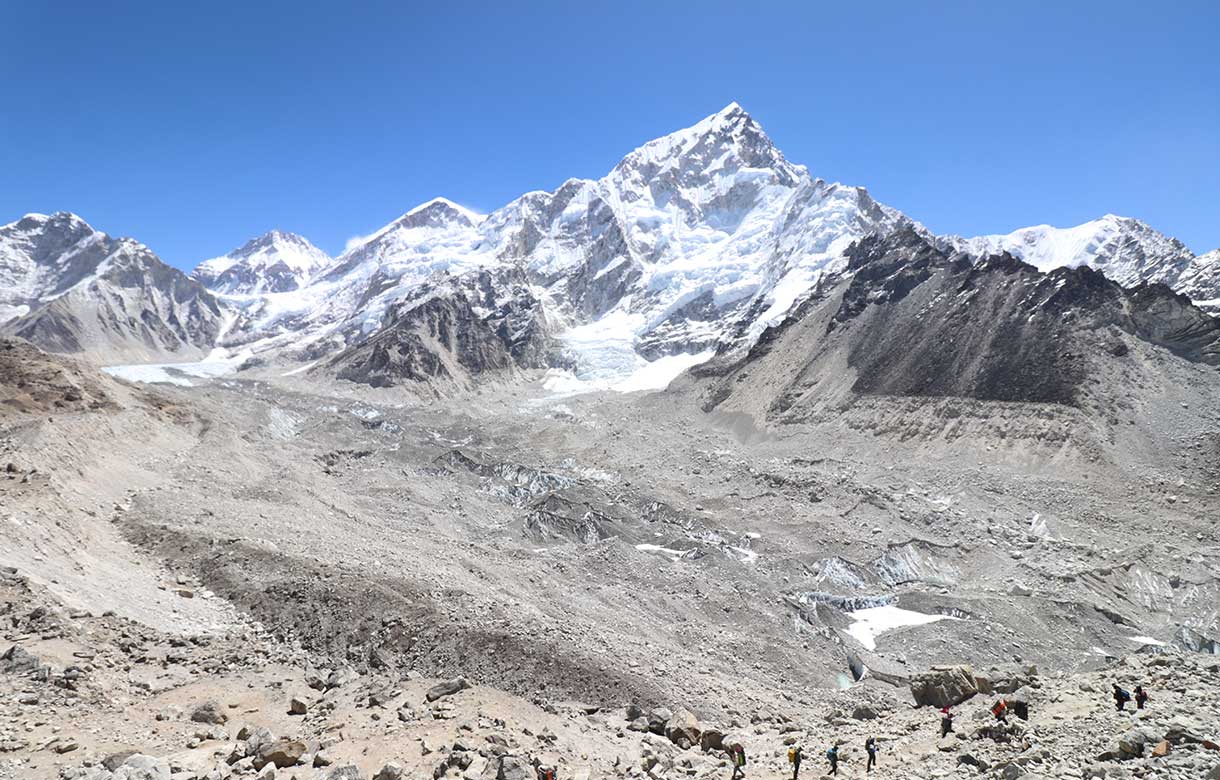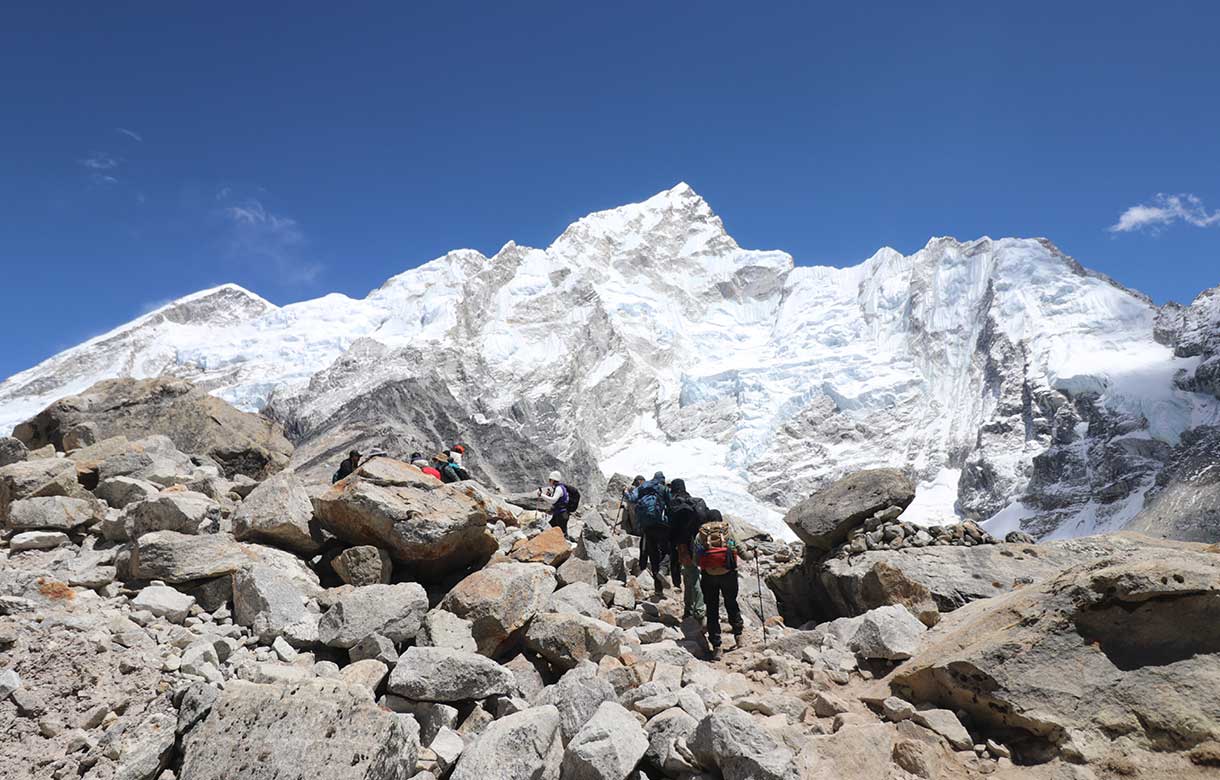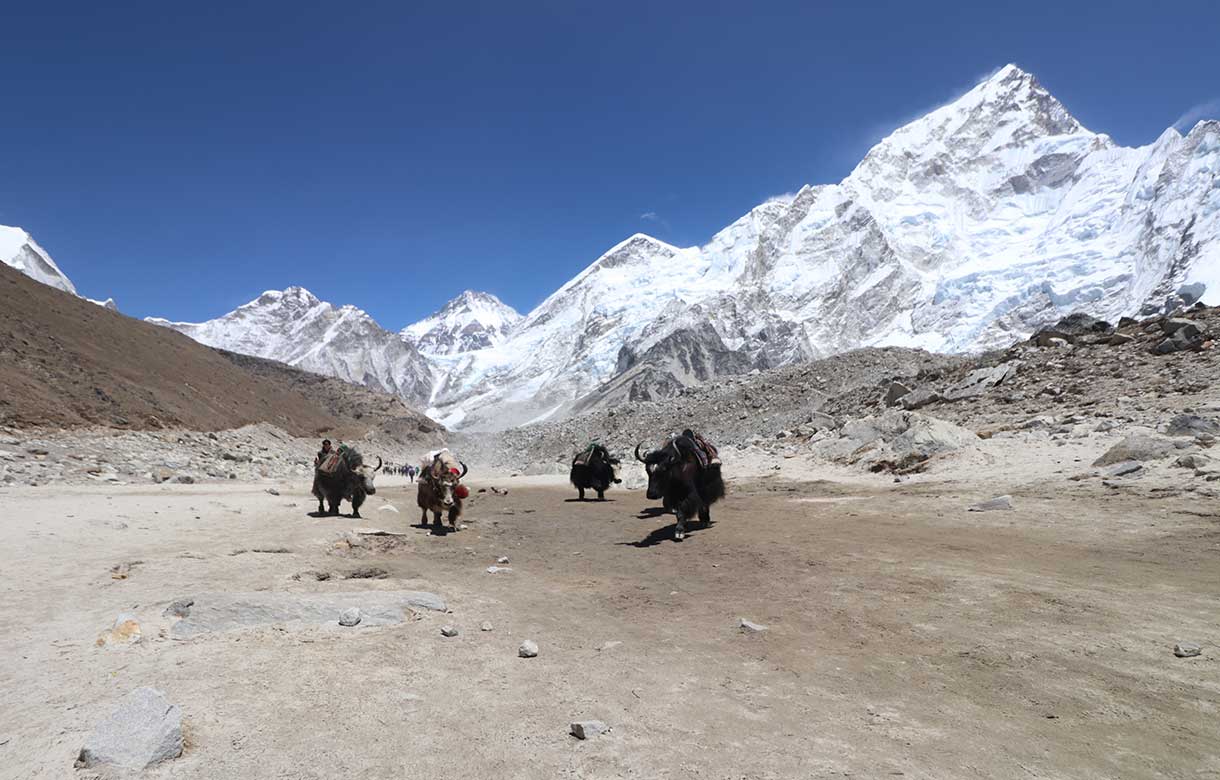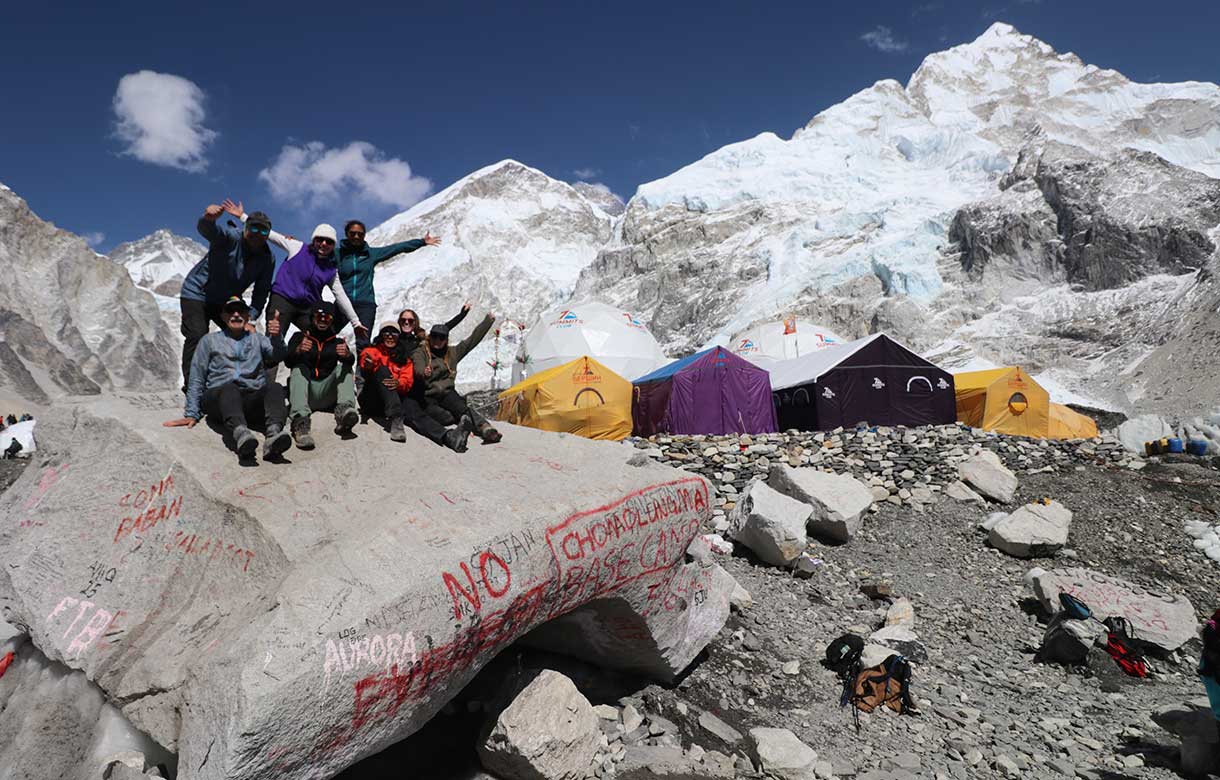If you have ever dreamed of standing in the shadow of the world’s tallest mountain, Mount Everest (8,848m/ 29,028ft), you have probably asked yourself why hike to Everest Base Camp? The answer goes far beyond than just simply reaching the Everest Base Camp (5,364m/ 17,598ft). This journey is about walking on a legendary path, experiencing the Sherpa culture and testing your own endurance in one of the most breathtaking sections on Earth. The Mt Everest hike to base camp is also about history and meaning. Every step you take retraces the routes of legendary climbers like Tenzing Norgay Sherpa and Sir Edmund Hillary, the first conquerors of Everest.
This sense of connection to Everest’s story is one of the main reasons why people from around the globe join this iconic trail. The scenery is another powerful reason why hiking to Everest Base Camp is worth it. Your journey begins in green valleys and rhododendron forest before leading you into high-altitude alpine terrain surrounded by towering peaks. The villages along the Everest Base Camp Trekking route, like Phakding, Namche, Tengboche and Dignboche, give you a glimpse into the Sherpa culture, traditions, lifestyle, their spiritual side and warm hospitality.
Likewise, this journey is also about personal achievement. Trekking to Everest Base Camp is challenging but achievable for anyone with determination and preparation. For many adventurers reaching the base camp is more than just ticking off a bucket-list adventure. It is a growing experience, pushing past one’s limits, embracing adventure and standing at the foot of the highest mountain in the world with a sense of triumph.

Why Hike to Everest Base Camp?
The hike to Everest Base Camp is not just a scenic walk; it is a journey into the heart of the Himalayas and one’s own resilience. For decades, trekking enthusiasts from every corner of the globe have asked the same question: Why Hike to Everest Camp? The answer? Well, it lies in the powerful combination of the legendary history, personal achievement and the unparalleled reward of culture, scenery and emotion that comes with this journey. And frankly, no other trek can match its energy.
Here are the key motivations that set the Everest Base Camp Trek apart from others:
-
Legendary Status of Mount Everest
Mount Everest (8,848m/ 29,028ft), the tallest natural structure on the planet that touches the heavens, holds a mythical place in the human imagination. This iconic peak is known as Sagarmatha in Nepali (translated to ‘Forehead of the Sky’) and Chomolungma in Tibetan (translated to ‘Goddess Mother of the World’). Mt Everest became globally legendary on 29th May 1953 when Sir Edmund Hillary and Tenzing Norgay Sherpa stood on its summit for the very first time.
That historic summit changed the perception of what was possible in human exploration. Ever since, Everest has become a symbol of perseverance and achievement, drawing climbers and trekkers from across the globe. So, Mt Everest hike to base camp allows you to experience a slice of this legend firsthand. Even if you don’t set food above base camp, being there makes you part of this legacy.
Personal Achievement and Bucket-List Adventure
Trekking Everest Base Camp is not about technical climbing, but it is more about endurance, preparation and determination. For many trekkers, reaching base camp represents one of the greatest personal milestones of their lives. It is a physical and mental test that rewards you with immense pride. Standing beneath the towering peaks at the core of the Himalayas at an elevation of 5,364 meters (17,598 feet) feels like a proof of resilience.
So, conquering this adventure and ticking it off your bucket list makes you feel that you have achieved something extraordinary in one of the most challenging environments on the planet.
Immersion in Sherpa Culture
This journey that leads you to the foothills of the tallest snow-clad peak in the world is as much cultural as it is physical. The charming Sherpa villages along the way, like Phakding, Namche, Tengboche and Dingboche, introduce you to warm hospitality, Buddhist traditions and the resilient lifestyle shaped by the high Himalayas. Everest Base Camp Trail is lined with monasteries, prayer wheels and fluttering flags, which will give you insights into not only cultural aspects but spiritual ones as well. Trekkers consider experiencing Sherpa heritage up close as one of the most enriching reasons why hike to Everest Base Camp feels so unique.
Unmatched Mountain Scenery
Only a few treks in the world offer as dramatic and varied landscapes as the trek to Everest Base Camp. From the low valley pine and rhododendron forest to glacial moraines and the rugged alpine terrain, every day on the trail feels like stepping into a new world. Along the way, you will see some of the most iconic Himalayan peaks such as Ama Dablam, Nuptse, Pumori, Changtse and of course Mount Everest. Sunrise from Kala Patthar, the glowing golden hues slowly spread across the towering peaks, is the type of otherworldly view that stays etched in memory forever.
Emotional and Transformative Experience
On the surface, this journey may feel like a physical feat; however, it also has a deeply emotional side. Every step you take during this journey has humility and there is joy in sharing the trail with the similarly spirited adventurers from all around the world. Many trekking enthusiasts who take part in the Everest Base Camp Trek describe the experience as transformative.
Well, that’s very true on many dimensions; this journey shifts perspectives, helps to build resilience and creates stories that you will be sharing for a lifetime. Thus, without a doubt, the hike to Everest Base Camp is a blend of physical endurance and emotional depth that makes the journey unforgettable.

Can Anyone Hike to Everest Base Camp?
Let’s move a little further from why hike to Everest Base Camp, let’s discuss if this journey is built for everyone? Well, the adventure compatibility is one of the most frequently asked questions among aspiring adventurers. Can anyone hike to Everest Base Camp? The answer is both encouraging and realistic. Unlike the Everest expedition, where you will be pushing for the summit of the tallest mountain in the world, this trekking journey to its foothills is far more accessible.
However, you need to understand that accessibility doesn’t mean that it's effortless. Your success rate on this conquest journey will depend on your preparation, fitness, mindset and understanding of the challenges in a high-altitude trek. Let's break down the segments for a clear understanding of the topic.
-
Required Fitness Level: To partake in this journey, you don’t need to be a professional athlete. Just a reasonable fitness will suffice. While moving along the Everest Base Camp Trekking route, you will need to walk around 5 to 6 hours on average each day. The difficulty level in this trek comes from stamina and endurance demand, not technical portions. So, at least basic fitness with good health is essential for this trek. If you can comfortably walk for several hours on hilly terrain carrying a light backpack, you already have the foundation needed.
-
Age Range of Trekkers: One of the most inspiring aspects of this trek is that a wide age range of people attempt it. You may have heard about the trekkers in their 60s conquering this mountain route. Or, the two-year-old kid from Scotland successfully reached the mountain’s foothills. So, from that the takeaway is that age is not a common factor, but preparation and determination. The database of different age demographics on the successful conquest of this route proves that with the right mindset and packing, the mountain welcomes enthusiasts across generations.
-
Accessibility for Beginners: Another popular question that is based around these eastern Himalayan peaks, besides why hike to Everest Base Camp?, is can you hike the ECB without prior trekking experience? The answer is yes, but with proper planning. The trek on this route is designed as a classical on-foot adventure, not as a mountaineering climb. You don’t need to overcome any technical segments, so it is accessible to even beginners. But, beginners need to approach this high-altitude mountain route with patience, respect for acclimatization and expert guidance (either from licensed local guides or trekking companies), which will ensure a high success rate.
Everest Base Camp Heights and Altitude Challenges
One of the most defining aspects of hiking to Everest Base Camp is its elevation. Yes, the EBC Trek route doesn’t involve any technical climbing. But, while comparing heights, you will cross the alpine zone, which has thin air conditions, making the journey both demanding and unforgettable. If you take your time to understand the Everest Base Camp heights along the route and the challenges that come along with elevation, you will be able to plan an efficient and safe adventure.
Key Elevation Points Along the Everest Base Camp Trek Route
Your journey on this historic route begins after a flight from Kathmandu (1,400m/ 4,593ft) to Lukla (2,860m/ 9,383ft), which is often called the ‘gateway to Everest’. From there, each day of your adventure gradually takes you higher across the series of Sherpa villages and acclimatization stops. Here are some of the key points in this trek:
-
Phakding— (2,610m/ 8,562ft)
-
Namche Bazaar— (3,440m/ 11,286ft)
-
Tengboche— (3,867m/ 12,687ft)
-
Dingboche— (4,410m/ 14,468ft)
-
Lobuche— (4,910m/ 16,108ft)
-
Gorakshep— (5,164m/ 16,942ft)
-
Everest Base Camp— (5,364m/ 17,598ft)
-
Kala Patthar— (5,550m/ 18,208ft)

Risk of Altitude Sickness
The higher you move along the trekking route, the thinner the air becomes. At the pinnacle of this journey, Everest Base Camp (5,364m/ 17,598ft), the oxygen level in the atmosphere is roughly about 50% of what it is at sea level. The greatest challenge of the EBC route is not the trail itself but the risk that comes along with it: Acute Mountain Sickness (AMS). The common symptoms of altitude sickness include:
-
Headache
-
Nausea
-
Fatigue
-
Dizziness
-
Shortness of breath
-
Insomania
-
Loss of appetite
Yes, in this moderate-level trekking route, way below the freezing slopes of Everest, there isn’t a risk of life-threatening conditions of altitude sickness like High Altitude Pulmonary Edema (HAPE) and High Altitude Cerebral Edema (HACE). But even just AMS can be quite bothersome and really put a dent in your experience. That is why a proper acclimatization calendar is essential. Our popular 12 Days Everest Base Camp Trek package includes acclimatization days at both Namche Bazaar (3,440m/ 11,286ft) and Dingboche (4,410m/ 14,468ft).
These acclimatization stops combined with a slow-paced walk will ensure that your body adapts gradually to the rising altitude. We also advise the trekkers to follow the golden rule of altitude: climb high, sleep low. It is also crucial to stay hydrated, eat a balanced diet, follow a gradual pace and avoid alcohol and caffeine
Hiking to Everest Base Camp Prep
An adequate level of preparation is what separates a smooth Mt Everest Hike to Base Camp experience from a challenging one. The walking trail itself is not technically challenging. But, the combination of long walking hours, high-altitude and unpredictable Himalayan weather demands that the trekkers should prepare their body and mind as well as gear in advance. If you are wondering how to begin your hiking to Everest Base Camp prep, here are the essentials that you need to emphasize:
Physical Training Before Trek
A common mistake that trekkers make is taking this journey as a ‘just walking’ journey. Yeah, it's true, you will be walking and there aren’t any technical sections along the way. But, make a note of the fact that you will be walking for 5 to 6 hours per day on a gradually rising rough mountain route. You will be moving along with those conditions for about two weeks. Thus, a good level of endurance and strength is crucial to ensure a smooth experience. For this high-altitude Himalayan route, it is best if you set a physical preparation period of 8 to 12 weeks. Focus on a gradual build-up combining cardio and strength exercises. Include practice hikes for an effective understanding of mountain landscapes and acclimatization needs.
-
Packing List Essentials
Having the right gear is another crucial part of hiking to Everest Base Camp prep. At the higher part of the Himalayas, the weather can be unstable and you will also traverse across different climatic zones. A well-balanced packing ensures comfort and safety. Manage your packing for clothing based on layers: base layers (thermal tops and bottoms), insulated mid-layers (fleece or down jacket) and waterproof outer shell. You will also need sturdy waterproof trekking boots (make sure to break them in before the trek to avoid blisters). For accessories, you need to bring warm hat, gloves, buff or gaiter, sunglasses and insulated socks. Trekking gear like sleeping bag (rated for -10°C to -15°C), backpack, duffel, trekking poles, water purification, headlamp, etc, will make the journey feel more comfortable.
Mental Preparation and Gradual Acclimatization
Mental preparation is one of the most overlooked parts when it comes to any kind of adventure. Trekking is no exception; many trekkers feel that just physical preparation will suffice for this mountain trip. However, this classical base camp route to the heart of the Himalayas will test your patience, discipline and determination. Some days on the trail will be physically exhausting, while others will be mentally draining. So being prepared for the slow progress, unpredictable weather and challenges of altitude mentally makes a huge difference. It's best if you choose the Everest Base Camp Trek itinerary with a well-managed pace and enough rest periods. This way, you won’t feel rushed, mentally drained and the risk of altitude sickness also drastically decreases.
Nutrition and Hydration Strategy
When you are climbing to higher altitudes, your body will burn more energy than usual. So, fueling it properly is also part of your prep. Eat healthy and nutritious meals at the teahouses during your trek, don’t go just for the taste. Carry high-energy snacks, nuts and energy bars for a quick energy boost when you need it. Hydration is also equally important during the high-altitude trek. While following the high-altitude demanding route for multiple hours, your body will lose a significant water level. That is why you should drink at least 3 to 4 liters of water per day during the trek. Always carry a reusable bottle or hydration bladder and use purification solution to treat water from taps (boiled water is the most cost-efficient and safest option).

When to Hike Everest Base Camp?
One of the most important decisions you will make before starting your Mt Everest Hike to Base Camp is choosing the right season for the journey. The weather conditions, especially in the high-altitude route like the Everest Base Camp Trek, can be unpredictable. The season you choose for your thrilling adventure has a direct impact on visibility, trail safety and overall trekking experience. Knowing the best time for Everest Base Camp Trek and what to expect in the off-season can make or break your trip.
Spring (March to May): The Classic Trekking Window
The spring season is arguably one of the best seasons for Himalayan trekking adventures in Nepal. During this season, the temperatures are moderate, rhododendron bloom across the lower trails and the skies are usually clear, offering breathtaking mountain views. This nature’s season also coincides with the peak climbing window. So, you will encounter mountaineering teams preparing for their summit attempts. Temperatures in this season are around 15°C to 20°C during the daytime and at night, they can drop up to 5°C to -5°C.
Autumn (September to November): Crisp Skies and Stable Weather
Autumn season rivals spring as the best season for Everest Base Camp Trek and is often considered the number one season for trekking in Nepal. After the monsoon rain stops, the air is fresh, the skies are at their clearest and the mountain visibility is unmatched. The stable weather conditions make room for smoother trekking conditions and the cultural vibrancy of this season adds extra charm to the adventure. Temperatures in the Everest region in autumn hover around 10°C to 18°C at lower altitudes. At the higher part of the trail, you can expect the temperatures to drop up to -5°C to -10°C.
Winter (December to February): Quiet Trail but Harsh Cold
For those who are seeking a journey in solitude, winter offers a peaceful trekking experience. The trekking trails are almost empty and the lodges are less crowded. But the trekkers need to brace for the extreme cold and heavy snow at higher elevations. While the lower sections of the trek remain manageable, higher villages like Lobuche and Gorak Shep can become challenging to access due to snow blocks. The teahouses at the higher part of the trail also shut down, making logistics more difficult. In this coldest point of the year, the temperatures remain around 8°C to -5°C and can drop drastically up to -20°C in the higher regions.
Monsoon (June to August): Lush but Wet
The summer monsoon season brings heavy rainfall to the lower sections, slippery trails and frequent flight cancellations to Lukla. Clouds often obscure the mountain views, but the valleys turn green and full of life. For those seeking a more adventurous experience with fewer crowds, monsoon trekking is possible. Though it may not be ideal for first-time trekkers. In this summer season, the temperatures can soar up to 25°C in the lower elevations and at the higher elevations they can fall up to 5°C to -5°C.
